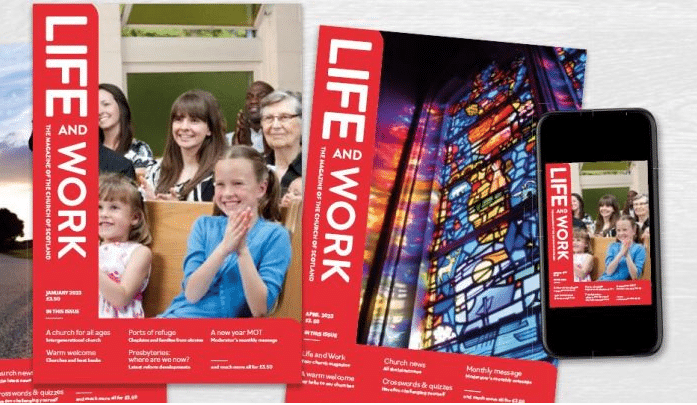The official magazine of the Church of Scotland is shutting down production as the Kirk strives to save money as it confronts a growing crisis of faith and finances. This will also see the Kirk, as the religious denomination is commonly known, closing and selling off hundreds of churches and places of worship.
For almost 150 years, <em>Life and Work</em>, which was once read by a quarter of the Scottish population – at its peak the magazine had a membership of more than 1.3 million – has served as the independent voice of the Church of Scotland, <mark style="background-color:rgba(0, 0, 0, 0)" class="has-inline-color has-vivid-cyan-blue-color"><a href="https://www.thetimes.com/article/aa5c6f29-905e-4d3b-9250-6f4868592630">reports </a></mark><em>The Times</em> of London.
The Church has announced “with heavy hearts” that the journal will cease publication this year, with the once-profitable title making losses amounting to more than £133,000 last year alone.
Lynne McNeil, who has edited<em> Life and Work</em> for 23 years, told the Kirk’s annual general assembly it was “the hardest of times” for the Church. “We are living in a market of diminishing returns,” she said.
McNeil conceded that an injection of further financial support would represent a mere stay of execution rather than salvation, says <em>The Times</em>.
“The reality is we would be facing the same situation in six to 12 months,” she said.
In the late 1950s,<em> Life and Work</em> was read by almost a quarter of the Scottish population. But since then, the number of worshippers registered with the Church has plummeted to about 240,000, with only 68,000 people reportedly attending services on Sundays.
Reverend Jim Stewart, who convenes the magazine’s advisory committee, said the decision to cease publication was a “seminal moment” as well as a tangible symbol of the problems facing the Church.
In December 2024, the Kirk confirmed its deficit had grown to £6.5 million, despite efforts to cut costs and increase revenue. As a result, the Church is in response planning to close about a third of its churches and sell off 400 places of worship, <em>The Times</em> reports.
“Difficult decisions will be necessary about what continues and what ceases,” Reverend David Cameron, the convener of the Kirk’s assembly trustees, said.
“We are not yet witnessing the anticipated recovery in the Church and our situation necessitates immediate and decisive action.”
<em>The Times</em> spoke to Matt Andrews, a <em>Life and Work </em>subscriber, who was dismayed by the announcement of its impending demise.
“The Church of Scotland’s decision to cease publication is another step towards managed decline,” he said.
“It is disheartening to see our Church led by people with no faith in anything but financial reports and pessimism. My heart goes to Lynn, the team and the readership.”
Rosemary Goring, a journalist and former <em>Life and Work</em> editor, said: “I am saddened to see it go. It is not entirely surprising though. In recent years the Church has been in freefall, haemorrhaging members and money so fast it has taken even the most cynical of it by surprise.
“It is not just the magazine that is under threat of extinction but the entire institution.”
Goring disclosed that her tenure as editor ended abruptly in 2002 when Church leaders objected to her “thoughtful, well-informed reflection” on the spiritual views of the then Prince of Wales, now King Charles III.
“Deeming it disrespectful to the royal family, they pulped the entire edition at a cost of thousands,” she said. “Bidding farewell to a magazine that has informed and enlightened the faithful for a century and a half seems to be signalling it [the Kirk] is reaching the end of the road.”
Next year’s general assembly will consider proposals for a new publication.
Last year it was confirmed that, for the first time, a majority of people in Scotland report that they are not religious.
The term "Kirk" is frequently used in everyday speech and in the Church's own literature as an informal name for the Church of Scotland. The Kirk of Scotland was officially used as the name of the Church of Scotland until the 17th century.
While the Kirk remains the largest religious group in Scotland, its numbers have halved in a decade.
In the<mark style="background-color:rgba(0, 0, 0, 0)" class="has-inline-color has-vivid-cyan-blue-color"> </mark><mark style="background-color:rgba(0, 0, 0, 0)" class="has-inline-color has-black-color">2022 census</mark>, 51 per cent of respondents said they had “no religion", up from 37 per cent in 2011. The change was driven by a sharp decline in the number of people describing themselves as being Church of Scotland or Roman Catholic.
“It is sobering, and we know that when the Church is measured in this way it can feel hurtful for our members and be a source of anxiety for many,” Cameron said. “But our faith and our relevancy cannot be expressed simply as a set of numbers in a table.”
<em>(Photo: screenshot from <a href="https://www.lifeandwork.org/"><mark style="background-color:rgba(0, 0, 0, 0)" class="has-inline-color has-vivid-cyan-blue-color">lifeandwork.org</mark></a>.)</em>



